Example 4 - stripy gradients
Contents
Example 4 - stripy gradients¶
SRFPACK is a Fortran 77 software package that constructs a smooth interpolatory or approximating surface to data values associated with arbitrarily distributed points. It employs automatically selected tension factors to preserve shape properties of the data and avoid overshoot and undershoot associated with steep gradients.
Notebook contents¶
The next example is Ex5-Smoothing
Define a computational mesh¶
Use the (usual) icosahedron with face points included.
import stripy as stripy
xmin = 0.0
xmax = 10.0
ymin = 0.0
ymax = 10.0
extent = [xmin, xmax, ymin, ymax]
spacingX = 0.2
spacingY = 0.2
mesh = stripy.cartesian_meshes.elliptical_mesh(extent, spacingX, spacingY, refinement_levels=3)
mesh = stripy.Triangulation(mesh.x, mesh.y, permute=True)
print("number of points = {}".format(mesh.npoints))
number of points = 15496
Analytic function¶
Define a relatively smooth function that we can interpolate from the coarse mesh to the fine mesh and analyse
import numpy as np
def analytic(xs, ys, k1, k2):
return np.cos(k1*xs) * np.sin(k2*ys)
def analytic_ddx(xs, ys, k1, k2):
return -k1 * np.sin(k1*xs) * np.sin(k2*ys) / np.cos(ys)
def analytic_ddy(xs, ys, k1, k2):
return k2 * np.cos(k1*xs) * np.cos(k2*ys)
analytic_sol = analytic(mesh.x, mesh.y, 0.1, 1.0)
analytic_sol_ddx = analytic_ddx(mesh.x, mesh.y, 0.1, 1.0)
analytic_sol_ddy = analytic_ddy(mesh.x, mesh.y, 0.1, 1.0)
%matplotlib inline
import matplotlib.pyplot as plt
def axis_mesh_field(fig, ax, mesh, field, label):
ax.axis('off')
x0 = mesh.x
y0 = mesh.y
trip = ax.tripcolor(x0, y0, mesh.simplices, field, cmap=plt.cm.RdBu)
fig.colorbar(trip, ax=ax)
ax.set_title(str(label))
return
fig = plt.figure(figsize=(10, 8), facecolor="none")
ax = fig.add_subplot(111)
axis_mesh_field(fig, ax, mesh, analytic_sol, "analytic solution")
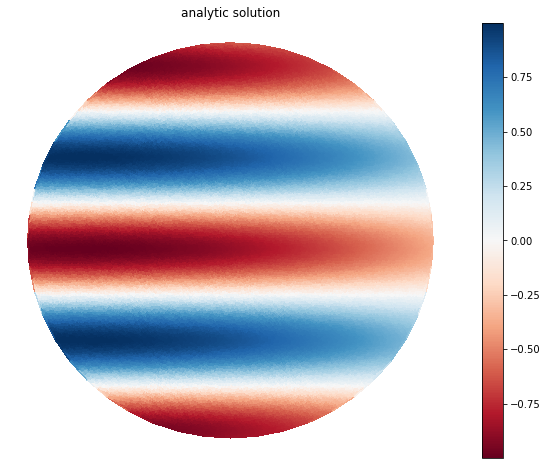
Derivatives of solution compared to analytic values¶
The gradient method of Triangulation takes a data array f representing values on the mesh vertices and returns the x,y derivatives.
Triangulation.gradient(f, nit=3, tol=0.001)
Derivatives of higher accuracy can be obtained by tweaking tol, which controls the convergence tolerance, or nit which controls the number of iterations to a solution. The default values are set to an optimal trade-off between speed and accuracy.
stripy_ddx, stripy_ddy = mesh.gradient(analytic_sol)
stripy_d2x, _ = mesh.gradient(stripy_ddx)
_, stripy_d2y = mesh.gradient(stripy_ddy)
fig, ax = plt.subplots(3,2, figsize=(12, 15), facecolor="none")
axis_mesh_field(fig, ax[0,0], mesh, analytic_sol, label="original")
axis_mesh_field(fig, ax[1,0], mesh, stripy_ddx, label="ddy")
axis_mesh_field(fig, ax[1,1], mesh, stripy_ddy, label="ddx")
axis_mesh_field(fig, ax[2,0], mesh, stripy_d2x, label="d2x")
axis_mesh_field(fig, ax[2,1], mesh, stripy_d2y, label="d2y")
ax[0,1].axis('off')
plt.show()
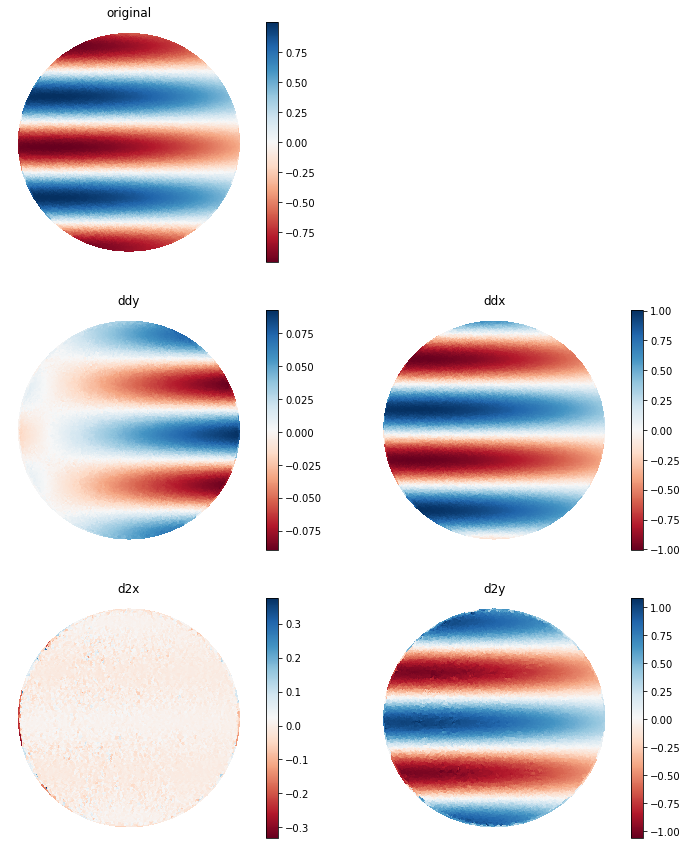
from stripy import _srfpack
def second_gradient_local(self, f, index):
"""
Return the gradient / 2nd partials of an n-dimensional array.
The method consists of minimizing a quadratic functional Q(G) over
gradient vectors (in x and y directions), where Q is an approximation
to the linearized curvature over the triangulation of a C-1 bivariate
function \\(F(x,y)\\) which interpolates the nodal values and gradients.
Args:
f : array of floats, shape (n,)
field over which to evaluate the gradient
nit : int (default: 3)
number of iterations to reach a convergence tolerance,
tol nit >= 1
tol: float (default: 1e-3)
maximum change in gradient between iterations.
convergence is reached when this condition is met.
Returns:
dfdx : array of floats, shape (n,)
derivative of f in the x direction
dfdy : array of floats, shape (n,)
derivative of f in the y direction
Notes:
For SIGMA = 0, optimal efficiency was achieved in testing with
tol = 0, and nit = 3 or 4.
The restriction of F to an arc of the triangulation is taken to be
the Hermite interpolatory tension spline defined by the data values
and tangential gradient components at the endpoints of the arc, and
Q is the sum over the triangulation arcs, excluding interior
constraint arcs, of the linearized curvatures of F along the arcs --
the integrals over the arcs of \\( (d^2 F / dT^2)^2\\), where \\( d^2 F / dT^2\\)is the second
derivative of \\(F\\) with respect to distance \\(T\\) along the arc.
"""
if f.size != self.npoints:
raise ValueError('f should be the same size as mesh')
sigma = self.sigma
iflgs = self.iflgs
f = self._shuffle_field(f)
index = self._shuffle_simplices(index)
## wrapping:
# subroutine gradc(k,ncc,lcc,n,x,y,z,list,lptr,lend,dx,dy,dxx,dxy,dyy,ier) ! in :_srfpack:srfpack.f
# subroutine gradg( ncc,lcc,n,x,y,z,list,lptr,lend,iflgs,sigma,nit,dgmax,grad,ier) ! in :_srfpack:srfpack.f
dx, dy, dxx, dxy, dyy, ierr = _srfpack.gradcs(index+1, self._x, self._y, f, self.lst, self.lptr, self.lend)
if ierr < 0:
raise ValueError('ierr={} in gradc\n{}'.format(ierr, _ier_codes[ierr]))
return dx, dy, dxx, dxy, dyy
def gradient_local(self, f, index):
"""
Return the gradient at a specified node.
This routine employs a local method, in which values depend only on nearby
data points, to compute an estimated gradient at a node.
`gradient_local()` is more efficient than `gradient()` only if it is unnecessary
to compute gradients at all of the nodes. Both routines have similar accuracy.
"""
if f.size != self.npoints:
raise ValueError('f should be the same size as mesh')
f = self._shuffle_field(f)
index = self._shuffle_simplices(index)
gradX, gradY, l = _srfpack.gradls(index + 1, self._x, self._y, f,\
self.lst, self.lptr, self.lend)
return gradX, gradY
indices = np.arange(0, mesh.npoints)
dx, dy = gradient_local(mesh, analytic_sol, indices)
stripy_ddy.shape, dx.shape
((15496,), (15496,))
fig, ax = plt.subplots(3,2, figsize=(12, 15), facecolor="none")
axis_mesh_field(fig, ax[0,0], mesh, analytic_sol, label="original")
axis_mesh_field(fig, ax[1,0], mesh, dx, label="ddx")
axis_mesh_field(fig, ax[1,1], mesh, dy, label="ddy")
axis_mesh_field(fig, ax[2,0], mesh, stripy_ddx, label="d2x")
axis_mesh_field(fig, ax[2,1], mesh, stripy_ddy, label="d2y")
ax[0,1].axis('off')
(0.0, 1.0, 0.0, 1.0)
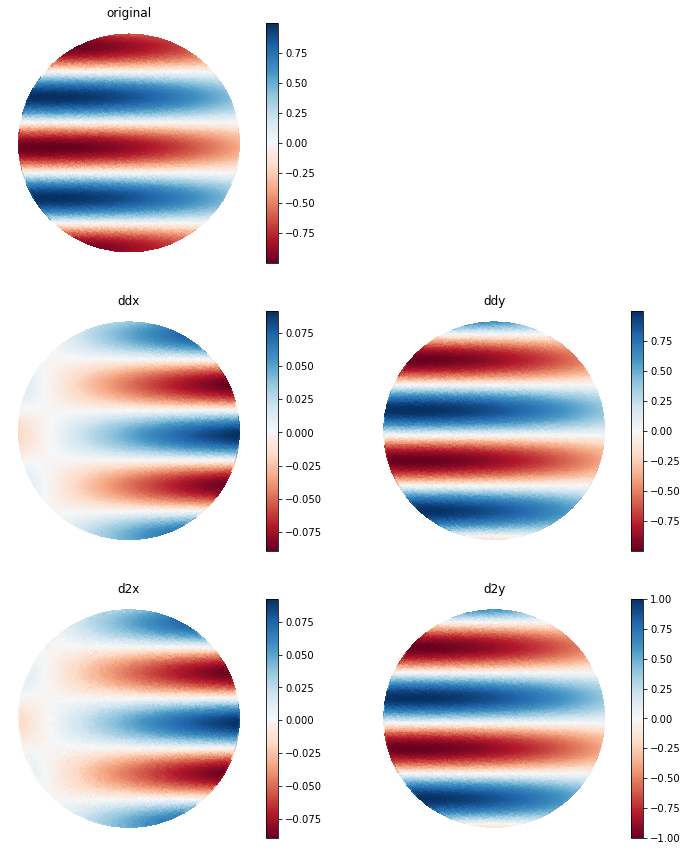
indices = np.arange(0, mesh.npoints)
dx, dy, dxx, dxy, dyy = second_gradient_local(mesh, analytic_sol, indices)
---------------------------------------------------------------------------
AttributeError Traceback (most recent call last)
/var/folders/24/8k48jl6d249_n_qfxwsl6xvm0000gn/T/ipykernel_3796/2564623685.py in <module>
1 indices = np.arange(0, mesh.npoints)
----> 2 dx, dy, dxx, dxy, dyy = second_gradient_local(mesh, analytic_sol, indices)
/var/folders/24/8k48jl6d249_n_qfxwsl6xvm0000gn/T/ipykernel_3796/166712891.py in second_gradient_local(self, f, index)
41 raise ValueError('f should be the same size as mesh')
42
---> 43 sigma = self.sigma
44 iflgs = self.iflgs
45
AttributeError: 'Triangulation' object has no attribute 'sigma'
d2x = np.zeros_like(stripy_d2x)
d2y = np.zeros_like(stripy_d2y)
d1x = np.zeros_like(stripy_d2y)
d1y = np.zeros_like(stripy_d2y)
for index in range(0, mesh.npoints):
dx, dy, dxx, dxy, dyy = second_gradient_local(mesh, analytic_sol, index)
d2x[index] = dxx
d2y[index] = dyy
d1x[index] = dx
d1y[index] = dy
---------------------------------------------------------------------------
AttributeError Traceback (most recent call last)
/var/folders/24/8k48jl6d249_n_qfxwsl6xvm0000gn/T/ipykernel_3796/3472454204.py in <module>
4 d1y = np.zeros_like(stripy_d2y)
5 for index in range(0, mesh.npoints):
----> 6 dx, dy, dxx, dxy, dyy = second_gradient_local(mesh, analytic_sol, index)
7 d2x[index] = dxx
8 d2y[index] = dyy
/var/folders/24/8k48jl6d249_n_qfxwsl6xvm0000gn/T/ipykernel_3796/166712891.py in second_gradient_local(self, f, index)
41 raise ValueError('f should be the same size as mesh')
42
---> 43 sigma = self.sigma
44 iflgs = self.iflgs
45
AttributeError: 'Triangulation' object has no attribute 'sigma'
fig, ax = plt.subplots(3,2, figsize=(12, 15), facecolor="none")
axis_mesh_field(fig, ax[0,0], mesh, analytic_sol, label="original")
axis_mesh_field(fig, ax[1,0], mesh, d1x, label="ddy")
axis_mesh_field(fig, ax[1,1], mesh, d1y, label="ddx")
axis_mesh_field(fig, ax[2,0], mesh, d2x, label="d2x")
axis_mesh_field(fig, ax[2,1], mesh, d2y, label="d2y")
ax[0,1].axis('off')
plt.show()
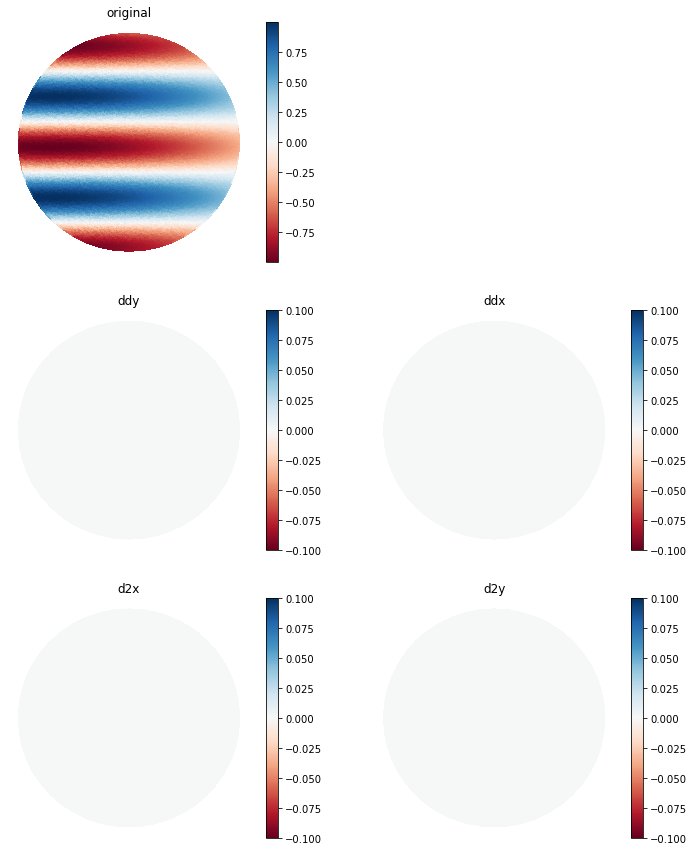
The next example is Ex5-Smoothing
dsdx, dsdy = mesh.gradient(analytic_sol)
print(dsdx[0], dsdy[0])
s, (dsdx, dsdy), err = mesh.smoothing(analytic_sol, np.ones_like(analytic_sol), 10.0, 0.8, 0.00001)
print(dsdx[0], dsdy[0])
0.048499703 0.24340674
0.04875533 0.24499807
fig, ax = plt.subplots(3,2, figsize=(12, 15), facecolor="none")
axis_mesh_field(fig, ax[0,0], mesh, analytic_sol, label="original")
axis_mesh_field(fig, ax[1,0], mesh, dsdx, label="ddy")
axis_mesh_field(fig, ax[1,1], mesh, dsdy, label="ddx")
axis_mesh_field(fig, ax[2,0], mesh, dsdx-analytic_sol_ddx, label="ddx_err")
axis_mesh_field(fig, ax[2,1], mesh, dsdy-analytic_sol_ddy, label="ddy_err")
ax[0,1].axis('off')
plt.show()
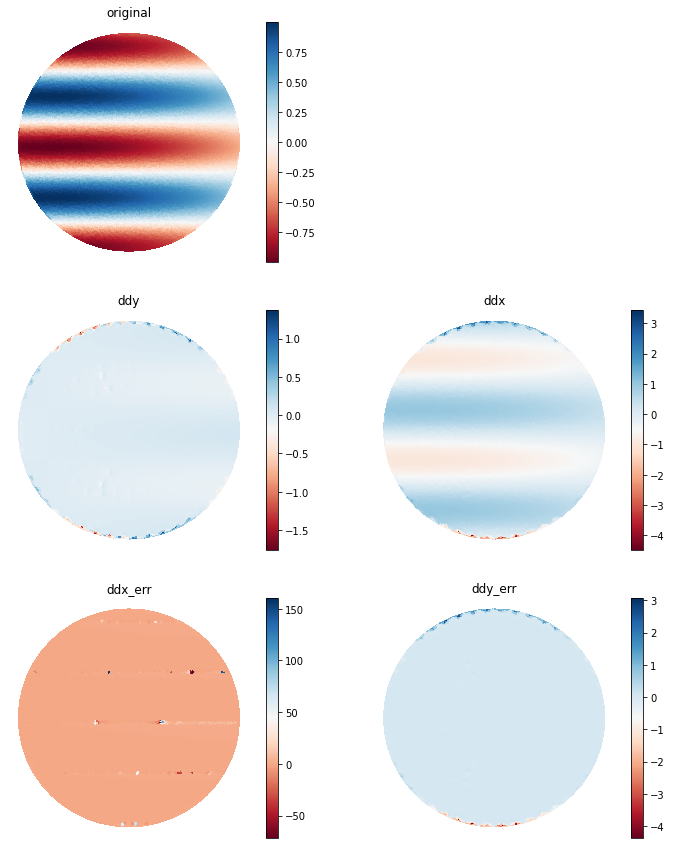
The next notebook is Ex5-Smoothing